The Colt Python versus the Ruger Blackhawk: Apples and oranges? Maybe, maybe not. This blog compares the two .357 Magnum revolvers from several perspectives, including price, actions and triggers, sights, barrels, fit and finish, durability, feel, panache, accuracy, bore leading, ammo sensitivity, and extraction.
Price
The Python is a premium revolver, selling for $1500 (if you can find one) compared to a Ruger Blackhawk’s typical sell price of just under $700. I believe Ruger stopped making Blackhawks for a while; they resumed production this year and I have one of the recently manufactured specimens. Colt stopped making the original Pythons in 1999; in 2020 they reintroduced an improved version. That’s the one I have now.
Actions and Triggers
The Python is a double action revolver; the Ruger is a single action. That means that on the Ruger, you have to cock it by pulling the hammer all the way to the rear to rotate the cylinder and bring the gun to a ready-to-fire condition. On a double action revolver like the Python, you can fire it single action as described immediately above, or you can pull the trigger a longer distance to rotate the cylinder, cock the gun, and drop the hammer.
Help us bring more content to you…please click on the popup ads!
As delivered, the Blackhawk had a crisp but relatively heavy single action trigger pull. I gave mine the quick New York trigger job described in an earlier blog; now it is both lighter and crisp. It’s a good trigger, as good as you’d get with a custom trigger job. Ruger did a good job here.
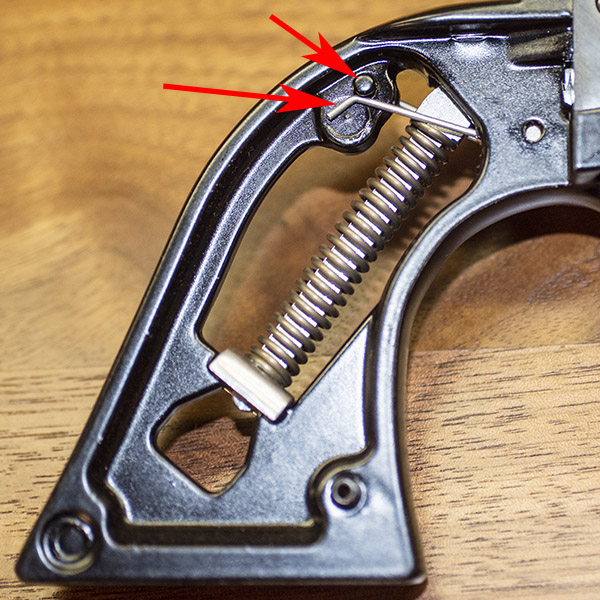
The Colt Python’s double action trigger pull is superb, far superior to the double action trigger of the earlier Pythons. It doesn’t stack; it’s a constant force trigger pull all the way to hammer drop. The Python trigger is serrated, which I don’t care for. I think it would be better as a smooth trigger, like the Ruger has. The serrations interfere with the double action trigger motion, in which I’d like my finger to be able to slide across the trigger laterally as I complete the pull. But it’s still a good double action trigger.
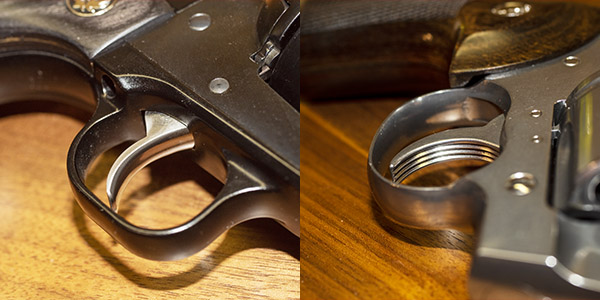
The Colt Python’s single action trigger, as delivered by the factory, was not acceptable to me. It probably exceeded 6 pounds, it was gritty, and it actually cocked the hammer a bit more before it released. I called my contact at Colt to ask about it and he explained that it’s necessary to survive our California drop test. That requirement stipulates that a cocked gun has to not discharge when dropped repeatedly from a specified height on a concrete surface. I run with a pretty exclusive crowd (exclusive in the sense that we don’t drop our loaded and cocked guns repeatedly on concrete), so the requirement is beyond silly to me, but hey, it is what it is, and it’s why a new Python has a heavy, gritty single action trigger from the factory. It’s not Colt’s fault; it’s California.
I had TJ (of TJ’s Custom Gunworks) work his magic on the single action trigger and it’s now what it is supposed to be. Think zero creep, a breaking glass release, and 2.5 pounds, and you’ll have a good idea of my Python’s single action trigger.
Sights and Sight Radius
Both revolvers have adjustable sights. The Python has a red ramp front sight (but no white outline rear). The Blackhawk has plain black sights front and rear, which I actually prefer. The Blackhawk rear sight is click adjustable for windage and elevation (like most handguns with adjustable rear sights), the Python rear sight is click adjustable for elevation. The Python windage adjustment is a little different than most. It is infinitely adjustable for windage via a screw (with no clicks), and it can be locked in place with what has to be the world’s smallest Allen screw. Colt provides a tiny Allen wrench with the revolver for this purpose.
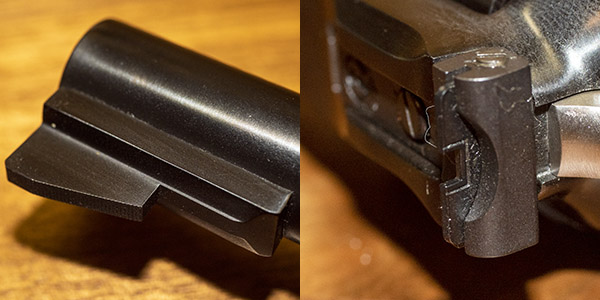
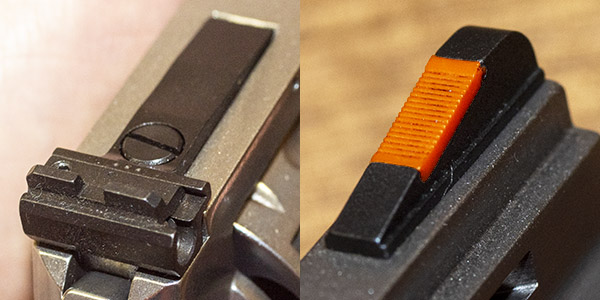
The Colt front sight is easily replaced with the same size tiny Allen screw that is used to lock the rear sight windage. I’ve not seen any different front sights offered to replace the red ramp front sight, but I guess they are (or will be) available.
I actually prefer the Ruger’s plain black sights to the Colt’s red ramp arrangement, but that’s a personal preference.
The Colt’s sight radius (the distance from the front to rear sight) is 7 3/4 inches. The Ruger’s sight radius is 8 1/2 inches, which should give a Ruger a slight accuracy edge.
Barrels
Both handguns have the longer version of the barrels offered by their respective manufacturers. The Ruger .357 Magnum New Model Blackhawk can be had with either a 4 5/8-inch barrel or a 6 1/2-inch barrel; I opted for the 6 1/2-inch barrel. The Colt Python is available with either a 4 1/4-inch barrel or a 6-inch barrel; I went with the 6-inch version. For me, these are target guns, and I wanted the longer sight radius.
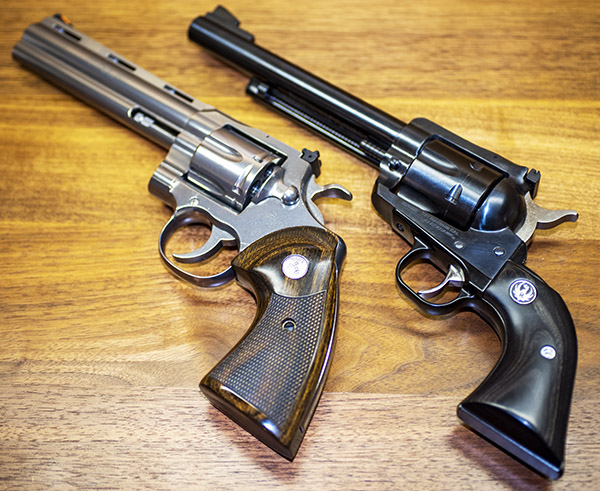
Colt is recently introduced a 3-inch barrel on the Python. The Python (in my opinion) is too big for concealed carry even with the 3-inch barrel; the short barreled version holds no interest for me.
The Python has a 1 turn in 14 inches left twist rate barrel; the Ruger has a slightly slower 1 turn in 16 inches right twist rate. Both barrels have recessed crowns. The Python, of course, has its signature ventilated rib and full underlug barrel. It’s a classic and unique look and I love it.
Interestingly, in the 1970s I shot handgun metallic silhouette competition with a Smith and Wesson Model 27; it had a twist rate of 1 turn in 18 3/4 inches. It was accurate, but not any more than either of the two 357 Magnums being reviewed here.
Weight
The Colt Python weighs 46 ounces. The Ruger Blackhawk weighs 45 ounces. The grip frame on the Blackhawk is a painted alloy, which reduces the weight slightly. These are both big, heavy handguns. They are not meant to be concealed carry guns.
Fit and Finish
Ah, how to be delicate here. Colt hit a home run with the Python. Ruger, not so much, at least on my Blackhawk.
The Python has a high polish, mirror-like finish on its stainless steel surfaces. It’s actually not hand buffed like you might imagine; Colt uses a vibratory polishing media approach. It really works; the finish is superb.
Ruger’s Blackhawk has an industrial grade blued finish, and on my revolver, the factory missed several spots on the cylinder. Ruger offered to reblue the cylinder for me, but truth be told, the cylinder is a fitted part and I didn’t want to chance sending it to Ruger and having them return a different cylinder. I used cold blue on mine to touch it up, and after oiling it, you have to know where the bluing shortfalls were to find them. But you shouldn’t have to do that on a new gun.
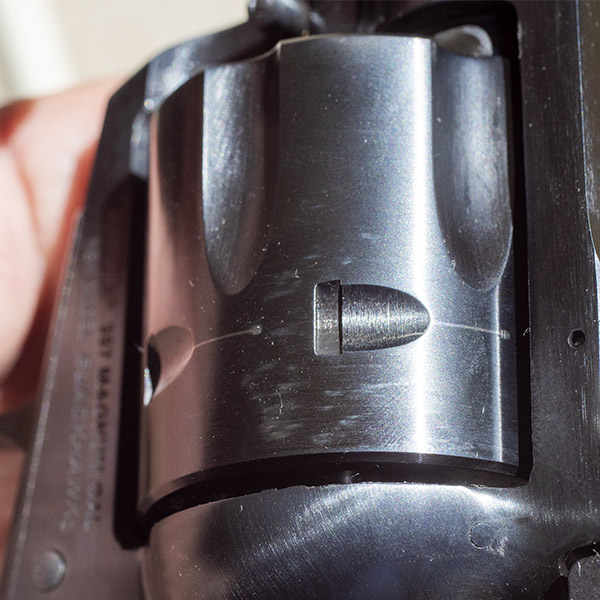
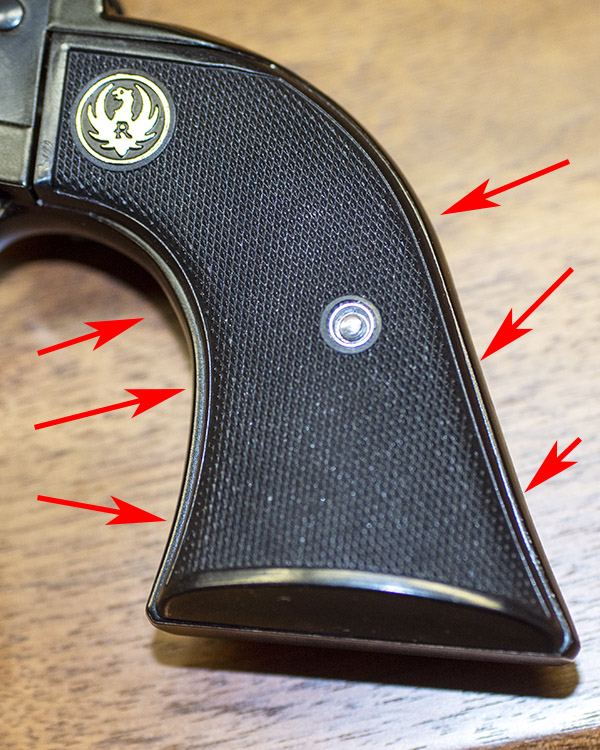
The grips on my Blackhawk had a very poor fit. I thought they were made of plastic, but they are hard rubber (like on the Colt Single Action Army). Ruger sent a new set of grips to me, but I couldn’t get them over the mounting posts in the grip frame and I didn’t want to screw around enlarging the holes. Instead, I installed a previous set of black laminate grips I had from Ruger (you can see them in the photo at the top of this blog). I like the look and the feel of the laminate grips, so they are staying on the gun. You shouldn’t have these kinds of issues on a new gun.
Both the Colt and Ruger rear sight elevation adjustment pivots on a pin through the revolver frame. After shooting the Colt for a couple of years, the pin is still in place. Colt uses a rolled steel pin; Ruger uses a solid pin. On the Ruger, by the end of the first range session its pin had backed out. Ruger sent me another pin with a recommendation that I bend it slightly before I install it. I’ll fix it in place with green Loctite when I get around to picking some up, but I shouldn’t have to do this.
I paid $659 for my Blackhawk, but factoring in the freight cost, the sales tax, the California DOJ fee, and the transfer fee, it was crowding a thousand dollars by the time I took it home. For that kind of money, I expect something to be perfect. That’s not what I received. On the plus side, I know if I shipped the revolver back to Ruger, they’d make it perfect. As I said in an earlier blog, Ruger’s customer service is the best in the business. But that’s a poor benchmark for a gun manufacturer (or any manufacturer, for that matter). If they got it right the first time, they wouldn’t need to be the best in the best in correcting quality escapes from the factory, and getting it right the first time is what most of us expect when we plunk down our hard-earned cash.
Durability
The older Pythons were delicate firearms, and it’s been said by people who know what they’re talking about they suffered from frame stretch and timing issues within the first 2,000 to 3,000 rounds. The new Python is a much beefier gun, and the guys I spoke with at Colt told me it no longer has these issues. I haven’t owned my Python long enough to say that’s the case, but I believe what Colt told me. I’ve shot mine a lot over the last two or three years; if anything, it’s becoming more accurate.
Ruger Blackhawks have always been built like anvils. I’m the only guy I know who wore one out, and I put many, many max loads through my old stainless steel Blackhawk. Blackhawks are tough. I think the new Pythons are, too. From a durability perspective, I’d call it a draw.
Feel
This is a subjective assessment that includes grip, balance, and ease in handling the revolver. It’s very much a matter of personal preference. I like the feel and balance of a single action better than a double action revolver, so for me, the Blackhawk takes the win here.
Panache
This is another subjective assessment. The dictionary defines panache as “flamboyant confidence of style or manner.” The Python is the easy winner here. Don’t get me wrong: Folks have approached me on the range to ask about what I’m shooting when I’ve been out there with both guns. But it happens more often with the the Python. It’s a prestige item. Pythons have been featured in movies going all the way back to the second Dirty Harry flick, Magnum Force, as well as others. I don’t know that I’ve ever seen a Ruger Blackhawk in a movie (if you have, let me know).
Accuracy
This is essentially a draw. Both revolvers are accurate, and both have their preferred loads. You may have read my recent blog on the Blackhawk’s accuracy; I shot the same loads with the Python to make a comparison.
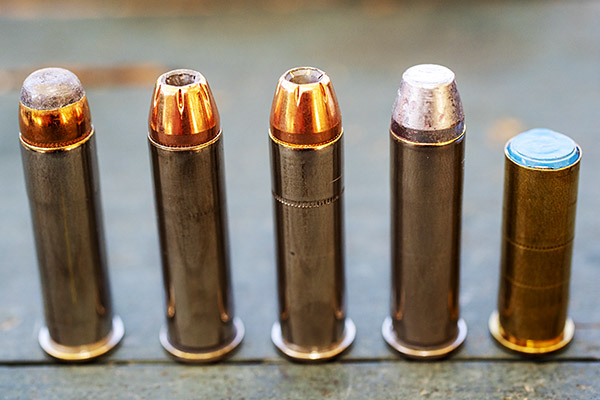
Take a look at the results:
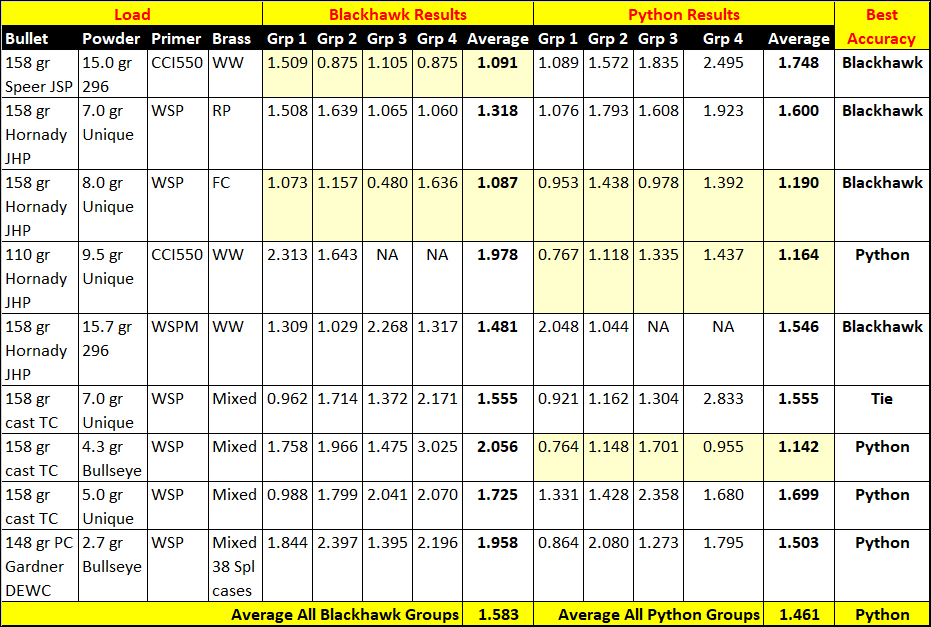
I fired the above 5-shot groups at 50 feet, using a two hand hold resting my hands on the bench. I did not use a machine rest, nor did I chronograph any of my loads.

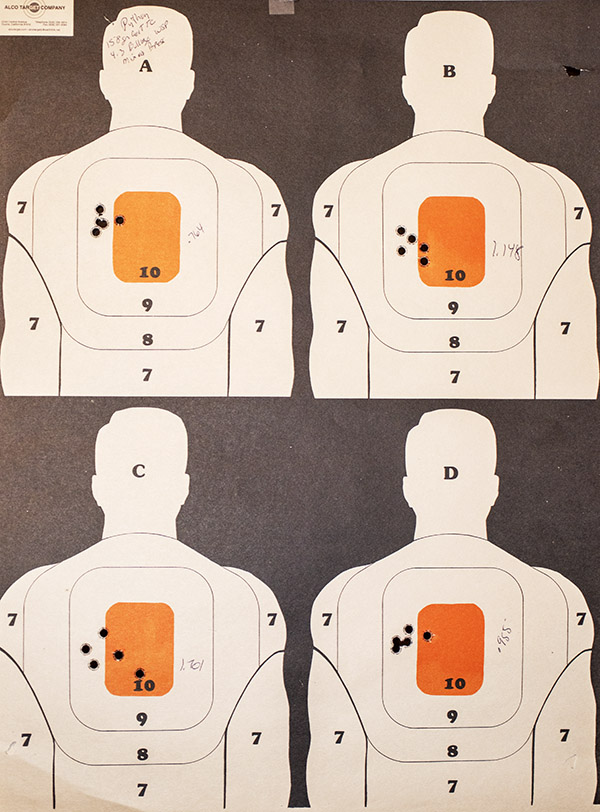
The clear winner for a full power load that works well in both guns is the 158-grain Hornady jacketed hollow point with 8.0 grains of Unique. That was the accuracy load for a 158-grain jacketed bullet in the old 45th edition (1970s vintage) Lyman manual (it’s not shown in the newer manuals). Loads using 158-grain jacketed bullets and Winchester’s 296 propellant did well in both guns, too, but they are high energy, high muzzle blast, and high recoil loads.
Another known favorite .357 Magnum load is the 110-grain Hornady jacketed hollow point with a max load of Unique. These performed superbly well in the Python, but they were terrible in the Blackhawk. The accuracy was poor and the brass would not extract (I had to remove the Blackhawk’s cylinder and drive the brass out with a rod). This load had previously worked well in a stainless steel Blackhawk, but this newer one did not digest this recipe well. Every gun is different.
I also tried a few lighter loads. The Python grouped very well with 4.3 grains of Bullseye and the 158-grain cast flat point bullet. That’s an easy load to shoot and I’ll be reloading a bunch of .357 Magnum cases with it later this week. It’s an easily recoiling load, it’s very accurate in the Python, and it doesn’t lead the bore. And a pound of Bullseye will go a long with this load (1627 cartridges, to be precise). I also tried my preferred .38 Special target load in both revolvers (2.7 grains of Bullseye and a 148-grain Gardner powder coated double ended wadcutter bullet loaded in .38 Special brass). The Python did well with these; the Blackhawk did not. In general, the Ruger didn’t do nearly as well with lighter loads.
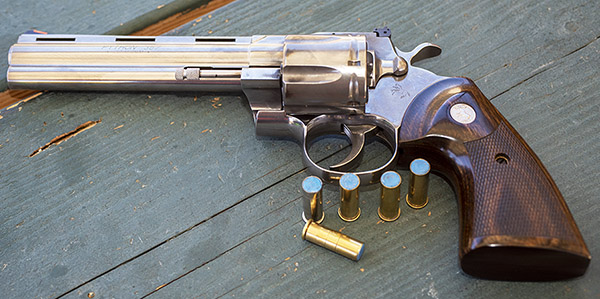
Overall, it’s hard to say one revolver is more accurate than the other. The table above shows amazing consistency for both guns. I averaged all the averages for each revolver, and from that statistic, one could conclude that the Python holds an accuracy edge. But you know what they say about statistics. From an accuracy perspective, both manufacturers (Colt and Ruger) got it right.
Extraction
The Python was flawless. The Ruger had extraction issues with the 110 grain bullet and a near-maximum load of Unique. Well, issues isn’t exactly the right word. Cases fired with those loads wouldn’t extract. I had to remove the cylinder and tap the cases out with a rod. All the other loads tested in the Ruger extracted normally.
The Python extracted the same load that gave the Ruger fits with no issues, and owing to the nature of a double action revolver’s extraction mechanism, it had to push out all the cases at the same time. The inside of the Python chambers have a mirror finish. The Ruger chambers do not.
With regard to extraction, the Python is the better revolver.
Leading
Neither revolver had an advantage over the other with regard to leading. When cast bullet velocities were high, both guns leaded the bore. If I loaded to get velocities below 1000 feet per second, neither revolver leaded the bore. But (and it’s an important but), the Python is more accurate than the Ruger with lower velocity cast bullet reloads.
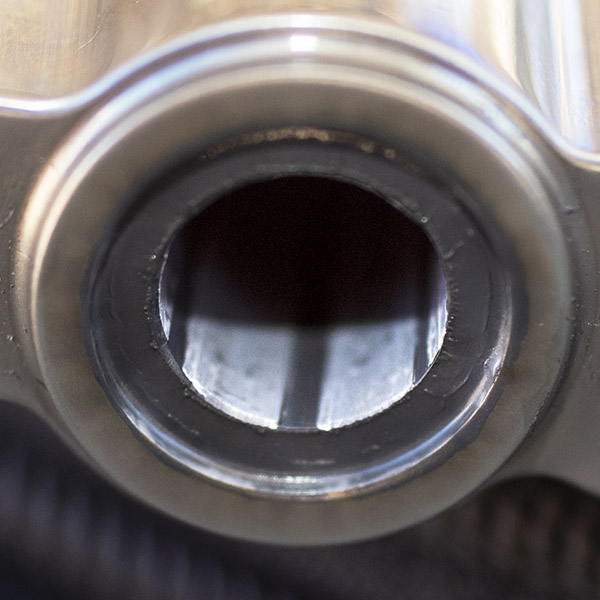
As I mentioned in an earlier blog, my old standard .357 Magnum load turned out to not be such a good load. It leaded the bore of the Python and the Ruger significantly after 10 rounds. The first five shot group grouped well; each succeeding group grew larger. Interestingly, that group averaged exactly the same (1.555 inches) for both the Python and the Blackhawk.
When I was finished with the Python accuracy testing, I know I’d have to scrub the lead out of the barrel with a bronze bore brush. From time to time, people ask if they can just shoot jacketed bullets when the bore leads up to “push the lead out.” I knew the answer to that question is a solid no, but I fired a few jacketed bullets through the heavily-leaded Python bore to make the point.
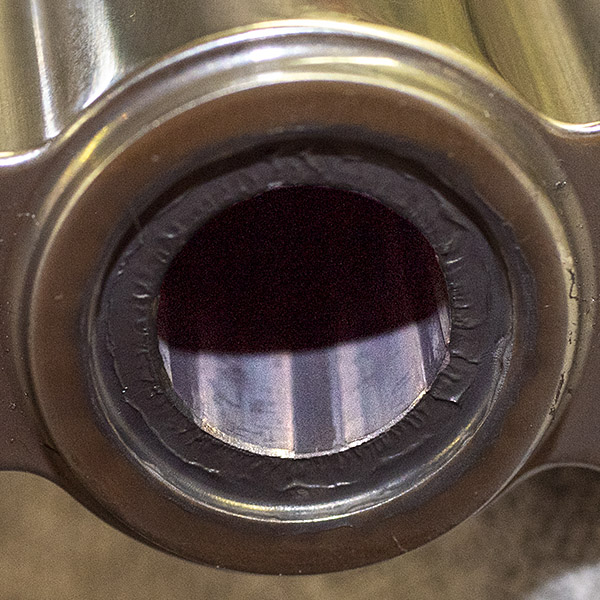
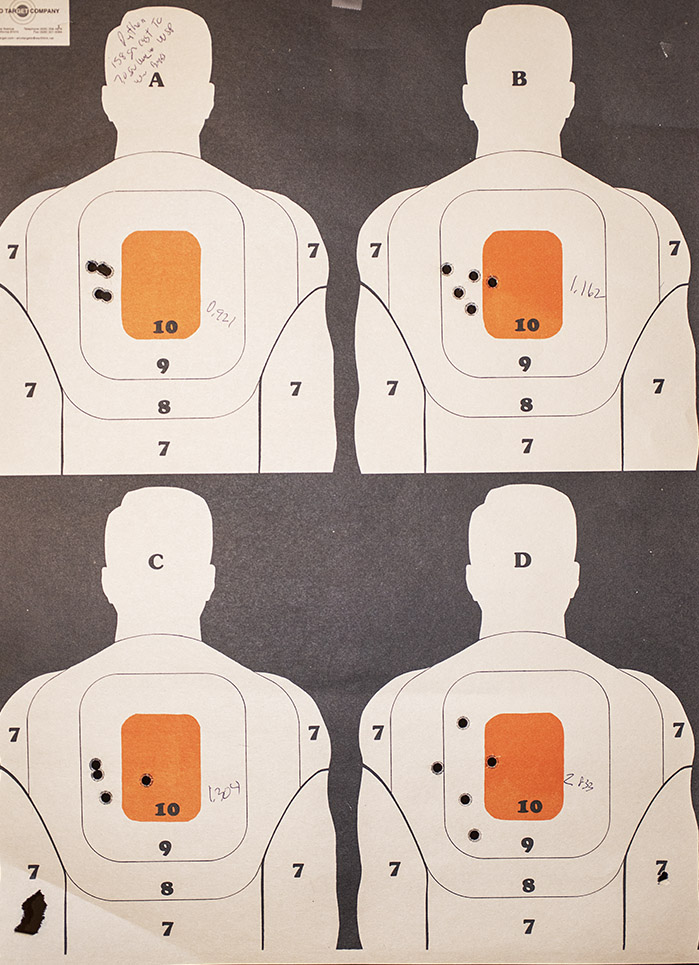
Ammo Sensitivity
I’ve already mentioned issues associated with extraction, and how the Python did better than the Ruger Blackhawk.
There’s another potential issue, and that’s bullet pull under recoil. The Ruger has a longer cylinder than the Python, and if bullet pull occurs, the Ruger is less susceptible to it preventing cylinder rotation.
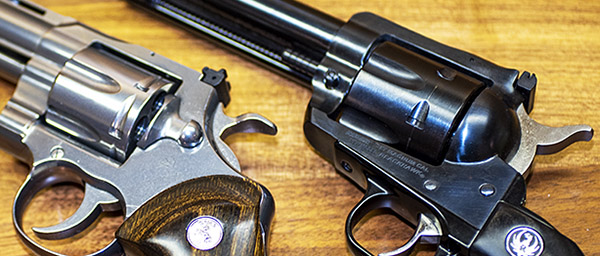
The Ruger has a 1.640-inch long cylinder. The Python has a 1.553-inch long cylinder. The Ruger gives you another 0.087 inches of cylinder length to play with, which would probably allow any recoil-induced bullet pull to go unnoticed (unless the cartridges had no crimp at all, the bullets most likely wouldn’t back out far enough in six rounds to affect cylinder rotation). In this regard, the Blackhawk will be more forgiving than the Python. Did Colt make the Python cylinder too short? Nope, they did not. They made it as long as it needs to be with adequately-crimped .357 Magnum ammo meeting the max cartridge overall length spec. The reason for that is accuracy. Keeping the distance the bullet has to jump to the rifling as low as it can be enhances accuracy. Colt got it right, in my opinion. I like the idea that cylinder length is minimized.
Conclusions
The bottom line to me is that you won’t be making a mistake by purchasing either handgun. I’d think twice about ordering the Blackhawk through one of the online sites; the better approach would be to purchase the gun at a store where you can see it first. On the Colt, you may not be satisfied with the single action trigger pull as delivered from the factory (I wasn’t, but it was recoverable with a trigger job).
From an accuracy perspective, it’s a draw; both guns are very accurate.
You might be wondering which of the two I prefer, and I don’t have an answer for you. I enjoy reloading for and shooting both.
Help us out, folks! We depend on our popup ads to keep us in components and chain lube. Please click on the popup ads!
Never miss an ExNotes blog:
Like our gun and reloading stuff? More Tales of the Gun are here!
We have a bunch of earlier blogs on the Ruger Blackhawk and the Colt Python. Here’s a set of links:
There you have it, folks. If you have comments, please make them. We love hearing from you.

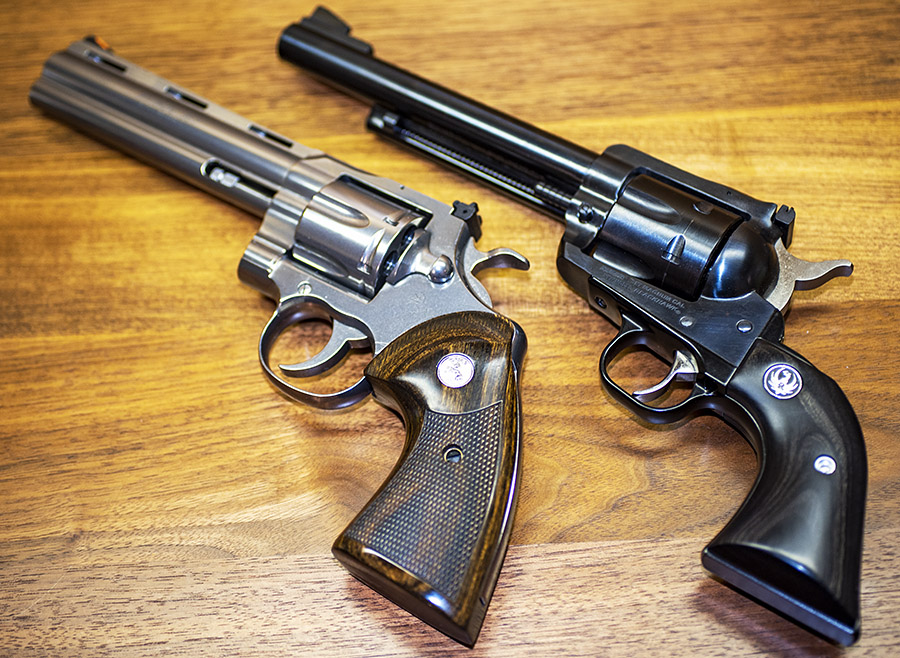
Great write up Joe, easily as interesting as a good motorcycle comparison. There is surprising (for me) detail here that comes only from intimate knowledge of guns. I’d like to see you compare screwdrivers, slotted not cross. One thing though.. I find it unnerving that the target profile is that of a man’s back. Why is that?
Thanks, Marcus.
I’ve had that comment before, about the silhouette being a man’s back. I’ve never seen it that way. I think the target makers picked up the convention of not whowing a person’s face to depersonalize the target. There are some out there that show a face, but more for comic effect than anything else.
A screwdrivere comparison? Hmmmm…
Mickey Rourke used a customized Ruger Blackhawk in “Harley Davidson and the Marlboro Man.” I think that’s the only time I’ve seen a Blackhawk in a movie.
I’ve the movie years ago but I missed that scene. I will look for it.
Thanks for commenting, Jim.